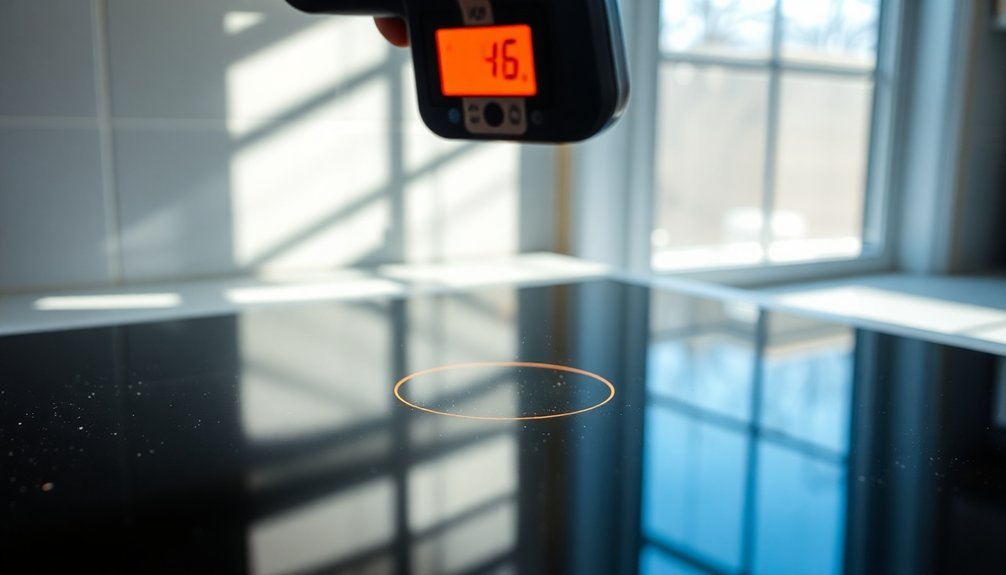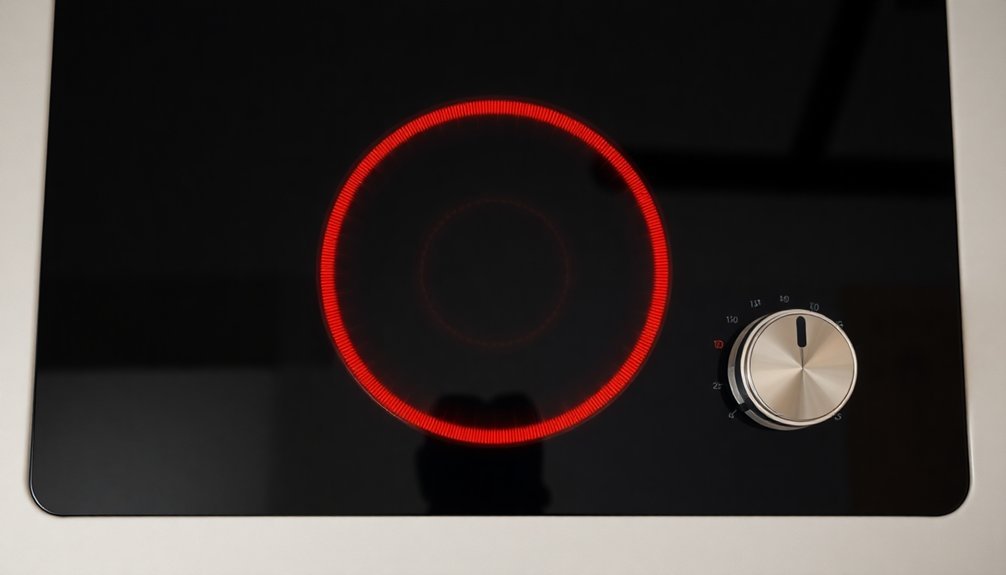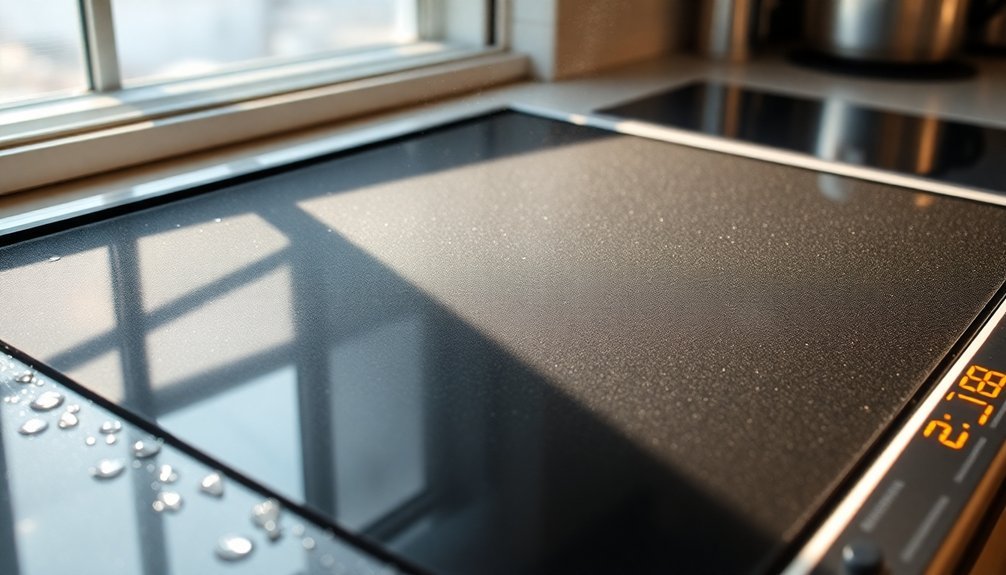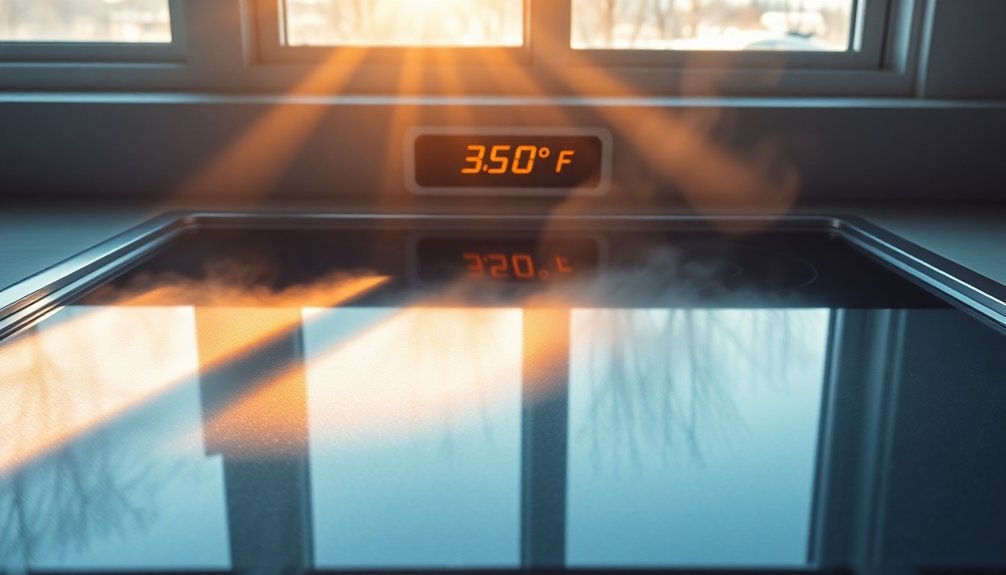You'll get the best cooking results by preheating your glass cooktop correctly for 8-15 minutes, depending on your desired temperature. For temperatures between 160-180°C, allow 8-10 minutes, while settings above 200°C need an additional 4-5 minutes. Always lift cookware instead of sliding it to protect the specialized glass surface, and center your pots directly over heating elements for ideal heat distribution. Remember to clean spills immediately with a soft, damp cloth to prevent staining, and use only flat-bottomed cookware for even heating. Understanding proper preheating techniques can enhance your cooking efficiency by up to 30%.
Understanding Solar Glass Cover Properties

Solar glass covers are engineered marvels that serve multiple critical functions in protecting and enhancing solar panels.
You'll find these specially designed covers are four times stronger than regular glass, offering superior protection against harsh weather conditions and potential impacts. They're built to withstand heavy snow loads and strong winds while maintaining their structural integrity.
The glass features advanced UV protection, blocking harmful UV-B and UV-C radiation while allowing beneficial UV-A light to pass through. These solar panels maintain high transmittance levels from UV-A through the near-infrared spectrum.
You'll benefit from its anti-reflective coating, which maximizes sunlight absorption and improves overall panel efficiency. The fire-polished surface guarantees excellent optical quality without requiring additional processing.
What's more, these covers act as electrical insulators, preventing current leakage while helping manage heat distribution across the panel's surface.
Optimal Preheating Time Windows
When it comes to preheating your oven, timing is everything for achieving consistent cooking results. You'll typically need 8-15 minutes to reach your target temperature, depending on your oven model.
For temperatures between 160-180°C, allow 8-10 minutes, while higher settings above 200°C require an extra 4-5 minutes.
You can optimize your preheating time by removing unused racks and keeping your oven clean. If you're using an electric oven, expect slightly longer preheating times compared to gas models. Always allow glass pans to rest for 30-60 minutes at room temperature before placing them in a preheated oven.
For better efficiency, don't open the door during preheating, and consider using a reliable oven thermometer to verify the temperature.
Some modern ovens feature quick-preheat technology that can greatly reduce your waiting time, while others with Frozen Bake Technology let you skip preheating altogether.
Temperature Control Methods

Maintaining precise temperature control in your oven starts with proper calibration and monitoring methods.
You'll need an oven thermometer placed in the center rack to verify your oven's actual temperature against its set temperature. Many home ovens are known to have temperature inaccuracies that can affect cooking results. For analog ovens, you can remove the control knob and adjust the internal dial until you achieve the desired temperature accuracy.
If you've got a digital oven, you'll need to follow your manufacturer's specific calibration steps. For instance, GE ovens require pressing the bake and broil buttons simultaneously until "SF" appears, then using arrow keys to adjust.
For professional-grade control, you can install a PID temperature controller, which uses precise sensors to maintain temperatures within 0.1°C accuracy.
Just remember to verify your adjustments with a reliable oven thermometer after any calibration changes.
Glass Cover Maintenance Tips
Proper temperature control goes hand-in-hand with keeping your oven's glass top in pristine condition.
You'll want to clean your glass surface regularly with a soft, damp cloth to prevent scratches and maintain its appearance.
When dealing with stubborn stains, don't reach for harsh cleaners. Instead, use a mixture of vinegar and water or create a paste with baking soda and lemon juice.
For burnt-on residue, you'll need a specialized glass cooktop scraper.
To protect your glass top, always lift cookware rather than sliding it, and inspect your pots and pans for rough spots that could cause scratches.
Don't store heavy items above the cooktop, and clean spills immediately to prevent etching.
Consider using a burner griddle or trivet for additional protection during cooking.
Weather Impact on Preheating

Weather conditions play a surprising role in your oven's preheating performance. If you're cooking in a cold kitchen, your oven will need extra time to reach the desired temperature, especially during winter months.
You'll notice this impact most in regions with harsh winters or high-altitude locations.
To optimize your preheating time, you can take several steps to maintain a warmer kitchen environment. Consider improving your kitchen's insulation and weather stripping to keep the cold air out.
If you live in an area with high humidity, you'll want to guarantee proper ventilation to help your oven perform efficiently.
You can also adjust your cooking schedule based on seasonal changes. During colder months, give your oven a few extra minutes to preheat, particularly if you haven't heated your kitchen beforehand.
Safety Measures While Preheating
You'll need to protect your glass top from sudden temperature changes by allowing it to warm up gradually to room temperature before use.
When placing items on the preheating surface, keep them centered and away from direct contact with heating elements to prevent damage.
Never set hot pans directly on cold surfaces or cold items on hot surfaces, as this can cause the glass to crack or shatter.
Temperature Change Protection Tips
To protect your glass cooktop from thermal shock, understanding temperature change precautions is essential.
Never place hot cookware directly on your cold glass surface, and don't use cold water for cleaning when the cooktop is hot. Instead, lift your pots and pans rather than sliding them, and use wire racks when transferring items from the oven.
You'll want to use heat diffusers as barriers between cast iron cookware and the glass surface.
Make sure you've properly seasoned your cast iron, coating both the interior and exterior with vegetable oil and baking it at 400 degrees for an hour. Repeat this process three to four times for ideal results.
When cleaning, use warm water and address spills immediately to prevent stubborn stains from baking onto the surface.
Proper Placement Guidelines
When preheating your oven for glass cookware, proper placement and safety measures are essential for preventing thermal shock and guaranteeing even cooking.
Position your glass pan on the center rack unless your recipe specifies otherwise, and make adjustments based on your oven type.
For best results, follow these key placement guidelines:
- In convection ovens, use the lower rack for large meat cuts and center rack for standard dishes.
- With gas ovens, place items slightly higher for better browning and rotate them periodically.
- Never block heat flow to upper racks when using multiple cooking levels.
Always consult your oven's manual for specific rack positioning instructions.
If you're using a metal baking sheet as a temperature buffer, make sure it doesn't interfere with proper heat circulation around your glass cookware.
Avoid Direct Heat Contact
Protecting your glass bakeware from thermal shock requires careful attention to temperature changes and direct heat exposure.
Don't place hot glass pans directly on cold surfaces or countertops, as this sudden temperature change can cause cracking or shattering. Instead, use a towel, cutting board, or cooling rack as a buffer.
You'll want to keep your glass bakeware away from temperature extremes. Never put a cold pan straight into a hot oven or move it directly from the freezer to high heat.
Let glass dishes come to room temperature for 30-60 minutes before use. When baking, keep the temperature at or below 350°F, and reduce it by 25 degrees compared to metal pan recipes.
Remember to avoid using glass bakeware on stovetops, under broilers, or in toaster ovens where direct heat can damage the glass.
Seasonal Preheating Adjustments

Different seasons bring unique challenges for preheating your glass-top oven. During colder months, you'll need to adjust your preheating time as room temperature greatly impacts how quickly your oven reaches the desired temperature.
To maintain consistent preheating performance year-round:
- Remove extra racks during winter months to reduce preheating duration.
- Use baking stones or cast-iron skillets to stabilize temperature.
- Keep your oven clean and properly calibrated each season.
If you're using a convection oven, subtract 25°F from standard recipe temperatures and expect faster preheating times of around 10 minutes.
For traditional gas ovens, allow 15-20 minutes. Don't forget to use an oven thermometer to verify actual temperatures, especially when seasonal changes affect your kitchen's ambient temperature.
Remember to minimize door opening to maintain consistent heat.
Glass Cover Positioning Techniques
When positioning cookware on your glass cooktop, you'll need to lift—never slide—pots and pans to protect the surface from scratches.
Your safest choice is lightweight stainless steel cookware with clean, smooth bottoms rather than heavy cast iron or ceramic pieces that could damage the glass.
Always use protective trivets or wire racks when transferring hot items from the oven to guarantee even heat distribution and prevent thermal shock to your cooktop's surface.
Glass Top Safety Rules
Safety on your glass cooktop starts with proper positioning techniques for cookware and protective covers.
You'll need to lift, not drag, your pots and pans to prevent scratches, and always use appropriately sized cookware to avoid heat deflection issues.
To protect your glass cooktop, follow these vital steps:
- Never place hot cookware directly on the surface – use wire racks instead.
- Keep protective plastic covers on when the cooktop isn't in use.
- Clean spills immediately with warm water to prevent baked-on residue.
Don't cover your cooktop with aluminum foil, as it traps heat.
When cleaning, avoid harsh scrubbing materials and extreme temperature changes.
If you notice any hairline cracks during your regular inspections, get them repaired promptly to maintain your cooktop's safety and efficiency.
Positioning For Heat Distribution
Proper positioning of cookware is essential for ideal heat distribution on your glass cooktop. Center your pots and pans directly over the heating element, ensuring they're 1 inch or smaller than the burner width. This alignment maximizes heat transfer while preventing hot spots.
You'll want to use a heat diffuser to create an effective barrier between your cookware and the glass surface. It'll help distribute heat evenly and protect against thermal shock.
When you're cooking, keep your pots and pans within their designated zones to maintain localized heating.
Don't slide your cookware across the surface – always lift it instead. This simple habit prevents scratches and extends your cooktop's life.
Remember to choose cookware with flat, smooth bottoms that fit snugly on the burner, and maintain low to medium heat settings for best results.
Frequently Asked Questions
Can I Use Glass Cleaners on My Oven's Glass Top While It's Warm?
No, you shouldn't use glass cleaners on a warm oven glass top. It can damage the surface and create permanent burns or pits. Always wait until the surface is completely cool before cleaning.
Why Does Condensation Form Under My Glass Top During Preheating?
Your oven's condensation forms when warm air hits the cold glass top during preheating. This happens because of the temperature difference between the heated interior and the cooler surface of your glass panel.
How Often Should I Replace the Rubber Seals Around the Glass Top?
You'll need to replace your rubber seals about every 12 months, but check them regularly. If you notice gaps, fraying, or brown streaks on the glass, don't wait – replace them immediately for proper function.
Does Using Aluminum Foil Under the Glass Top Affect Preheating Efficiency?
Don't place aluminum foil under your glass top – it'll reduce preheating efficiency by blocking heat distribution and can permanently damage your stovetop. The foil may also melt and fuse to the surface.
What Causes Dark Spots to Appear on My Glass Top After Prolonged Use?
Your glass top's dark spots typically come from burnt-on food spills, oil splatters, and mineral deposits. They'll appear when you don't clean spills promptly or when cookware leaves metal marks during use.
In Summary
You'll get the most from your solar oven by properly preheating the glass cover. Remember to adjust your preheating time based on the season and weather conditions, and always follow safety protocols when handling the hot glass. Keep your glass cover clean and properly positioned, and you'll achieve better, more consistent cooking results. When in doubt, take the extra time to preheat – it's worth the wait.





Leave a Reply